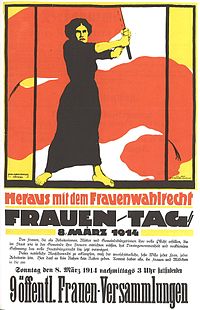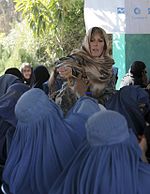- International Women's Day
-
International Women's Day 
Poster for Women's Day, March 8, 1914Observed by Men and Women worldwide Type International Significance Civil awareness day
Women and girls day
Anti-sex dayDate March 8 (annually) Related to Mother's Day, Universal Children's Day, International Men's Day International Women's Day (IWD), originally called International Working Women’s Day, is marked on March 8 every year.[1] In different regions the focus of the celebrations ranges from general celebration of respect, appreciation and love towards women to a celebration for women's economic, political and social achievements. Started as a Socialist political event, the holiday blended in the culture of many countries, primarily Eastern Europe, Russia, and the former Soviet bloc. In many regions, the day lost its political flavour, and became simply an occasion for men to express their love for women in a way somewhat similar to a mixture of Mother's Day and St Valentine's Day. In other regions, however, the original political and human rights theme designated by the United Nations runs strong, and political and social awareness of the struggles of women worldwide are brought out and examined in a hopeful manner.
Contents
History
 Female members of the Australian Builders Labourers Federation march on International Women's Day 1975 in Sydney
Female members of the Australian Builders Labourers Federation march on International Women's Day 1975 in Sydney
The first national Women's Day was observed on 28 February 1909 in the United States following a declaration by the Socialist Party of America.[2] In August 1910, an International Women's Conference was organized to precede the general meeting of the Socialist Second International in Copenhagen. Inspired in part by the American socialists, German Socialist Luise Zietz proposed the establishment of an annual 'International Woman's Day' (singular) and was seconded by Clara Zetkin, although no date was specified at that conference.[3] Delegates (100 women from 17 countries) agreed with the idea as a strategy to promote equal rights, including suffrage, for women.[4] The following year, on 18 March, 1911, IWD was marked for the first time, by over a million people in Austria, Denmark, Germany and Switzerland. In the Austro-Hungarian Empire alone, there were 300 demonstrations[3] In Vienna, women paraded on the Ringstrasse and carried banners honouring the martyrs of the Paris Commune.[3] Women demanded that women be given the right to vote and to hold public office. They also protested against employment sex discrimination.[2] Americans continued to celebrate National Women's Day on the last Sunday in February.[3]
In 1913 Russian women observed their first International Women's Day on the last Sunday in February (by Julian calendar then used in Russia). In 1917 demonstrations marking International Women's Day in St.Petersburg on the last Sunday in February (which fell on 8 March on the Gregorian calendar) initiated the February Revolution.[2]
Following the October Revolution, the Bolshevik Alexandra Kollontai persuaded Lenin to make it an official holiday in the Soviet Union, and it was established, but was a working day until 1965. On May 8, 1965 by the decree of the USSR Presidium of the Supreme Soviet International Women's Day was declared a non working day in the USSR "in commemoration of the outstanding merits of Soviet women in communistic construction, in the defense of their Fatherland during the Great Patriotic War, in their heroism and selflessness at the front and in the rear, and also marking the great contribution of women to strengthening friendship between peoples, and the struggle for peace. But still, women's day must be celebrated as are other holidays."[citation needed]
From its official adoption in Russia following the Soviet Revolution in 1917 the holiday was predominantly celebrated in communist and socialist countries. It was celebrated by the communists in China from 1922, and by Spanish communists from 1936.[5] After the founding of the People's Republic of China on October 1, 1949 the state council proclaimed on December 23 that March 8 would be made an official holiday with women in China given a half-day off.[6]
In the West, International Women's Day was first observed as a popular event after 1977 when the United Nations General Assembly invited member states to proclaim March 8 as the UN Day for Women's Rights and International Peace.[7][1]
2010 International Women's Day
On the occasion of 2010 International Women's Day the ICRC drew attention to the hardship displaced women endure. The displacement of populations is one of the gravest consequences of today's armed conflicts. It affects women in a host of ways.[8]
Women displaced by armed conflict – often living alone with their children – are frequently exposed to sexual violence, discrimination and intimidation. Many face poverty and social exclusion as well. International humanitarian law therefore includes specific provisions protecting women, for example when they are pregnant or as mothers of young children.[9]
2011 International Women's Day
 The mimosa (technically, the Silver Wattle) is the symbol of the celebrations of Women's day in Italy and Russia
The mimosa (technically, the Silver Wattle) is the symbol of the celebrations of Women's day in Italy and Russia
Events took place in more than 100 countries[10] on March 8, 2011 to commemorate the 100th anniversary of International Women's Day.[11] In the United States, President Barack Obama proclaimed March 2011 to be "Women's History Month", calling Americans to mark IWD by reflecting on "the extraordinary accomplishments of women" in shaping the country's history.[10] Secretary of State Hillary Clinton launched the "100 Women Initiative: Empowering Women and Girls through International Exchanges", on the eve of IWD.[12] In the run-up to 2011 International Women's Day, the International Committee of the Red Cross (ICRC) called on States and other entities not to relent in their efforts to prevent rape and other forms of sexual violence that harm the lives and dignity of countless women in conflict zones around the world every year.[13]
Australia issued a 100th anniversary commemorative coin.
In modern culture
The day is an official holiday in Afghanistan,[14] Armenia,[15] Azerbaijan,[16] Belarus,[17] Burkina Faso,[18] Cambodia,[19] China (for women only),[20] Cuba,[citation needed] Georgia,[21] Guinea-Bissau,[14] Eritrea,[14] Kazakhstan,[22] Kyrgyzstan, Laos,[23] Macedonia (for women only), Madagascar (for women only),[24] Moldova,[25] Mongolia,[26] Montenegro,[citation needed], Nepal (for women only),[14] Russia,[14] Tajikistan,[14] Turkmenistan,[14] Uganda,[14] Ukraine,[14] Uzbekistan,[14] Vietnam,[citation needed] and Zambia.[27]
In some countries, such as Cameroon,[28] Croatia,[29] Romania,[30] Bosnia and Herzegovina[citation needed], Serbia[citation needed], Bulgaria[citation needed] the day is not a public holiday, but is widely observed nonetheless. On this day it is customary for men to give the women in their lives – mothers, wives, girlfriends, daughters, colleagues, etc. – flowers and small gifts. In some countries (such as Bulgaria and Romania) it is also observed as an equivalent of Mother's Day, where children also give small presents to their mothers and grandmothers.[30]
The 1932 Soviet poster dedicated to the 8th of March holiday. The text reads: "8th of March is the day of rebellion of the working women against kitchen slavery" and "Down with the oppression and narrow-mindedness of household work!". Originally in the USSR the holiday had a clear political character, emphasizing the role of the Soviet state in the liberation of women from their second-class-citizen status.In Armenia, after the collapse of the Soviet Union celebrations of IWD were abandoned. Instead, April 7 was introduced as state holiday of ‘Beauty and Motherhood’. The new holiday immediately became popular among Armenians, as it commemorates one of the main holidays of the Armenian Church, the Annunciation. However, people still kept celebrating IWD on March 8 as well. Public discussion held on the topic of two ‘Women’s Days’ in Armenia resulted in the recognition of the so called ‘Women’s Month’ which is the period between March 8 and April 7.
In Italy, to celebrate the day, men give yellow mimosas to women.[31][32] Yellow mimosas and chocolate are also one of the most common March 8 presents in Russia and Albania.
In many countries, such as in Bosnia and Herzegovina, Brazil, Bulgaria, Croatia, Estonia, Hungary, Latvia, Lithuania, Macedonia, Moldova, Montenegro, Romania, Russia, Serbia, Slovakia and Slovenia, the custom of giving women flowers still prevails. Women also sometimes get gifts from their employers. Schoolchildren often bring gifts for their teachers, too.
In countries like Portugal groups of women usually celebrate on the night of 8 March in "women-only" dinners and parties.[citation needed]
In Pakistan working women in formal and informal sectors celebrate International Women's Day every year to commemorate their ongoing struggle for due rights, despite facing many cultural and religious restrictions. Some women working for change in society use IWM to help the movement for women's rights. In Poland, for instance, every IWD includes large feminist demonstrations in major cities.[33]
In 1975, which was designated as International Women’s Year, the United Nations gave official sanction to, and began sponsoring, International Women's Day.
The 2005 Congress (conference) of the British Trades Union Congress overwhelmingly approved a resolution calling for IWD to be designated a public holiday in the United Kingdom.
Since 2005, IWD has been celebrated in Montevideo, either on the principal street, 18 de Julio, or alternatively through one of its neighbourhoods. The event has attracted much publicity due to a group of female drummers, La Melaza, who have performed each year.[34]
Today, many events are held by women's groups around the world. The UK-based marketing company Aurora hosts a free worldwide register of IWD local events [35] so that women and the media can learn about local activity. Many governments and organizations around the world support IWD.
70% of those living in poverty are women, Oxfam GB encourages women to Get Together [36] on International Women's Day and fundraise to support Oxfam projects, which change the lives of women around the world. Thousands of people hold events for Oxfam on International Women's Day, join the celebration by visiting the website and registering your event! - International Women's Day, what better excuse to Get Together![37]
Controversies
In some cases International Women's Day has led to questionable practices that discriminated against men. For example Tower Hamlets Council closed off one of its libraries to all males to "celebrate" the occasion, forcing them to travel elsewhere, going as far as even banning male staff from the premises.[38]
In the Czech Republic (then part of Czechoslovak Socialist Republic), huge Soviet style celebrations were held annually. After the fall of Communism, the holiday, generally considered to be one of the major symbols of the old regime, fell into obscurity. International Women's Day was re-established as an official "important day" by the Parliament only recently, on the proposal of the Social Democrats and Communists. This has provoked some controversy as a large part of the public as well as the political right see the holiday as a relic of the nation's Communist past. In 2008, the conservative Catholic People's Party's deputies unsuccessfully proposed the abolition of the holiday. However, some non-government organizations consider the official recognition of International Women's Day as an important reminder of women's role in the society. Still, unlike in the past, the holiday is no longer observed by the general public in any significant way.[citation needed]
International Women's Day sparked violence in Tehran, Iran on March 4, 2007, when police beat hundreds of men and women who were planning a rally. Police arrested dozens of women and some were released after several days of solitary confinement and interrogation.[39] Shadi Sadr Mahbubeh Abbasgholizadeh and several more community activists were released on March 19, 2007, ending a fifteen day hunger strike.[40]
Apocrypha
A popular apocryphal story which surfaced in French Communist circles[41][42] claimed that women from clothing and textile factories had staged a protest on 8 March 1857 in New York City.[43] The story alleged that garment workers were protesting against very poor working conditions and low wages and were attacked and dispersed by police. It was claimed that this event led to a rally in commemoration of its 50th anniversary in 1907. Temma Kaplan[41] explains that "neither event seems to have taken place, but many Europeans think March 8, 1907 inaugurated International Women's Day."[41] Speculating about the origins of this 1857 legend, Liliane Kandel and Françoise Picq suggested it was likely that (in recent times) some felt it opportune to detach International Women's Day from its basis in Soviet history and ascribe to it a more "international" origin which could be painted as more ancient than Bolshevism and more spontaneous than a decision of Congress or the initiative of those women affiliated to the Party.[1][42]
See also
- International Day for the Elimination of Violence against Women
- International Men's Day
- Mother's Day
- Susan B. Anthony Day
- UN Women
- Women's rights
References
- ^ a b c Origins and Evolution: Perspectives of Two International Days
- ^ a b c United Nations page on the background of the IWD
- ^ a b c d Temma Kaplan, "On the Socialist Origins of International Women's Day", Feminist Studies, 11/1 (Spring, 1985)
- ^ About International Women's Day
- ^ Nelson, Jinty. "International Women’s Day: a centenary to celebrate". History Workshop Online. http://www.historyworkshop.org.uk/international-womens-day-a-centenary-to-celebrate/. Retrieved 28 August 2011.
- ^ "Anniversaries of important events". China Factfile. Chinese Government. http://www.gov.cn/english/2005-08/10/content_28291.htm. Retrieved 28 August 2011.
- ^ WomenWatch.
- ^ Women and displacement: strength in adversity International Committee of the Red Cross.
- ^ International Women's Day: giving a say to displaced women International Committee of the Red Cross.
- ^ a b Sindelar, Daisy. "Women's Day Largely Forgotten In West, Where It Got Its Start". Radio Free Europe. Radio Free Europe. http://www.rferl.org/content/womens_day_feature_soviet_socialist_origins_100th_anniversary/2330712.html. Retrieved 8 March 2011.
- ^ Pasha, Masroor Afzal. "To commemorate 100th International Women’s Day". Daily Times. Daily Times. http://www.dailytimes.com.pk/default.asp?page=2011\03\08\story_8-3-2011_pg12_3. Retrieved 8 March 2011.
- ^ McKellogg, JulieAnn. "Clinton Launches 100th Anniversary of International Women's Day". VOA News. voanews.com. http://www.voanews.com/english/news/Clinton-Launches-100th-Anniversary-of-International-Womens-Day-117556638.html. Retrieved 8 March 2011.
- ^ International Women's Day: the fight against sexual violence must not falter, ICRC.
- ^ a b c d e f g h i j [1]Angola.
- ^ Armeniainfo.am.
- ^ MSNtour.az.
- ^ (Russian) President's decree on public holidays in Belarus, 1998.
- ^ Visarequest.co.za.
- ^ Cambodiaevisa.com.
- ^ Mofcom.gov.cn.
- ^ [2].
- ^ E.gov.kz.
- ^ Laoyp.com.
- ^ QPPstudion.net.
- ^ (Romanian) Article 111 (1c) of the work codex of Moldova, PDF, page 53 "Article 111. Non-working holidays. (1) in Moldova, non-working holidays, maintaining the average salary, are: (...) c) March 8 - International Women's Day; (...)".
- ^ Mongolia-web.com.
- ^ QPPstudion.net.
- ^ QPPstudio.net
- ^ (Croatian) Zakon o blagdanima, spomendanima i neradnim danima u Republici Hrvatskoj
- ^ a b http://www.agentia.org/monden/ziua-interna-ional-a-femeii-de-8-martie-google-posteaza-un-desen-pentru-acest-eveniment-8533.html
- ^ (Italian) la Repubblica/societa: 8 marzo, niente manifestazione tante feste diverse per le donne.
- ^ Repubblica.it » politica » Festa della donna, parla Ciampi "La parità è ancora lontana".
- ^ IPPF.org.
- ^ Uruguaynow.com.
- ^ Internationalwomensday.com.
- ^ www.oxfam.org.uk/womensday
- ^ www.oxfam.org.uk/womensday
- ^ Thelondonpaper.com.
- ^ BBC.CO.UK.
- ^ HRW.ORG.
- ^ a b c Temma Kaplan, On the Socialist Origins of International Women's Day, in: Feminist Studies, 11, 1985, S. 163-171. (PDF)
- ^ a b Liliane Kandel / Françoise Picq, Le Mythe des origines à propos de la journée internationale des femmes, in: La Revue d'en face, 12, 1982, S. 67-80.
- ^ Angela Howard Zophy, Handbook of American women's history, Garland, 1990, 187.
External links
- Women and war - International Committee of the Red Cross
- International Museum of Women
- Article from international communist organization on International Women's Day
- Differences between International Women's Day and International Men's Day
- International Women's Day 2007 - United Nations web site
- Internationalwomensday.com
- International Women's Day Celebration
- More detailed overview
- Sewing a better future on International Women’s Day
- Towards International Women's Day 2011
- Worldwide Stamps Released On International Women's Day
- Wings & Dreams: 4 Elements of a New Feminism
- International Women’s Day Marked Around the World - video by Democracy Now!'
- International Women's Day - live blogging from Reuters
- On IWD's centenary, historian Jinty Nelson looks at its genesis and achievements - and the ground still to cover
 Public holidays in RussiaNew Year's Day/New Year · Defender of the Fatherland Day · International Women's Day · International Workers' Day · Victory Day · Russia Day · Unity DayCategories:
Public holidays in RussiaNew Year's Day/New Year · Defender of the Fatherland Day · International Women's Day · International Workers' Day · Victory Day · Russia Day · Unity DayCategories:- Civil awareness days
- Feminism
- Holidays in Russia
- Holidays in the Soviet Union
- International observances
- March observances
- United Nations days
- Women
- Recurring events established in 1908
Wikimedia Foundation. 2010.



